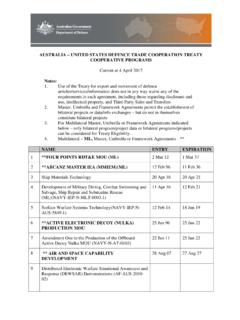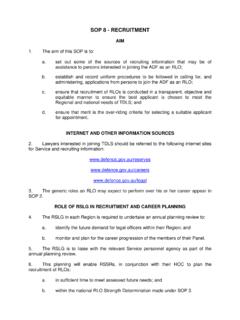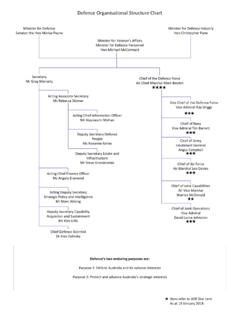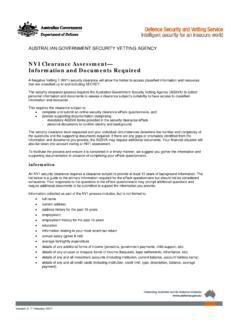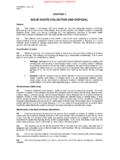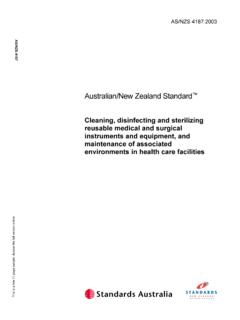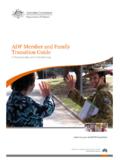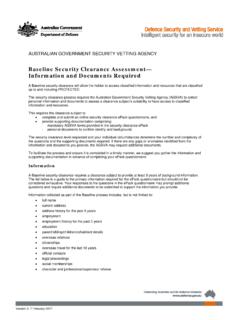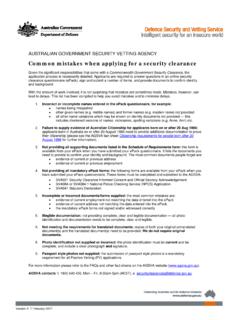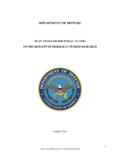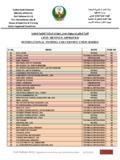Transcription of SOVEREIGN INDUSTRIAL CAPABILITY PRIORITIES - …
1 defence INDUSTRIAL CAPABILITY PLAN1 SOVEREIGN INDUSTRIAL CAPABILITY PRIORITIESFACT SHEETWhat are SOVEREIGN INDUSTRIAL CAPABILITY PRIORITIES ? SOVEREIGN INDUSTRIAL CAPABILITY PRIORITIES are capabilities that are critical to defence and must be developed or supported by Australian industry. This means Australia must have access to, or control over the skills, technology, intellectual property, financial resources and infrastructure that underpin the PRIORITIES . The PRIORITIES represent a subset of the INDUSTRIAL capabilities that defence relies on to deliver its core objectives and will be managed closely across defence and industry planning. SOVEREIGN INDUSTRIAL CAPABILITY PRIORITIES are those INDUSTRIAL capabilities assessed as: `operationally critical to the defence mission; ` PRIORITIES within the Integrated Investment Program over the next three to five years.
2 Or `in need of dedicated monitoring, management, and support due to their INDUSTRIAL complexity, Government priority, or requirements across multiple CAPABILITY initial SOVEREIGN INDUSTRIAL CAPABILITY PRIORITIES are (in no particular order): `Collins Class submarine maintenance and technology upgrade `Continuous shipbuilding program (including rolling submarine acquisition) `Land combat vehicle and technology upgrade `Enhanced active and passive phased array radar CAPABILITY `Combat clothing survivability and signature reduction technologies `Advanced signal processing CAPABILITY in electronic warfare, cyber and information security, and signature management technologies and operations `Surveillance and intelligence data collection, analysis dissemination and complex systems integration `Test, evaluation, certification and systems assurance `Munitions and small arms research, design, development and manufacture `Aerospace platform deep maintenance The SOVEREIGN INDUSTRIAL CAPABILITY PRIORITIES identify a number of elements of the Australian defence INDUSTRIAL base at a CAPABILITY rather than company or technology level.
3 This encourages innovation in existing technologies and provides flexibility in supporting current critical capabilities. Each SOVEREIGN INDUSTRIAL CAPABILITY Priority is expanded in more detail Class submarine maintenance and technology upgrade `Australian industry must have an ability to enhance, sustain, repair, operate and upgrade our submarine CAPABILITY . `Particular importance is placed on the sonar sub-system, tactical and weapons control system, signature management and endurance. Endurance includes batteries for energy storage and propulsion SHEET 120/04/2018 1:15 PMDEFENCE INDUSTRIAL CAPABILITY PLAN2 Continuous shipbuilding program (including rolling submarine acquisition) `Australian industry must have the technical, managerial, heavy engineering and advanced manufacturing capabilities required to build an innovative, cost-competitive, sustainable and continuous program that delivers Australia s future submarines, major surface combatants and minor war vessels.
4 `Australian industry will need to be integrated into global supply chains, have modern, productive and secure shipyards, and employ a highly skilled workforce both for shipbuilding and sustainment. `Establishing 21st century shipyards for design, construction and optimal production efficiency of our future submarines, frigates and minor war vessels is critical to achieve the CAPABILITY , reform and efficiency dividends combat vehicle and technology upgrade `Australian industry, including members of vehicle supply chains, must have the CAPABILITY and capacity to design, develop, manufacture and integrate new systems and equipment for next generation capabilities. `Australian industry must also have the ability to update and upgrade systems and equipment to enable the Australian defence Force s land combat vehicles to meet current and future challenges.
5 `Broad Australian industry involvement in the delivery of the new Combat Reconnaissance Vehicle program, for example, will ensure Australia develops the SOVEREIGN CAPABILITY to maintain a lethal, relevant and effective CAPABILITY into the future. Enhanced active and passive phased array radar CAPABILITY `Phased array radar CAPABILITY is only one element of a broader system, but it is a critical one where Australia has a world leading CAPABILITY and advantage. `The ability to detect adversary forces actively or passively seeking to operate with similar discretion will be critical to offensive and defensive operations in all environments. `Australian industry must possess the ability to design, develop, manufacture, maintain and upgrade passive and active electronically-scanned array radar systems.
6 Combat clothing survivability and signature reduction technologies `Australian industry must possess the ability to provide significant operational advantages through signature reducing characteristics and enhanced blast protection incorporated into the soldier combat ensemble. `Australian industry must be positioned to refine, enhance and upgrade stealth and survivability technologies to provide a level of force protection that gives our soldiers a warfighting edge. `Only the specific technologies relevant to signature reduction and ballistic protection are considered part of this SOVEREIGN INDUSTRIAL CAPABILITY Priority. As such, general combat clothing is not an element of this signal processing CAPABILITY in electronic warfare, cyber and information security, and signature management technologies and operations `Australian industry must understand, design, develop and use technology applications to maintain an advanced signal processing CAPABILITY in the area of cyber and information security, radar, sonar and acoustic technologies, electronic warfare operational support (including threat recognition, targeting and planning), and signature management.
7 Surveillance and intelligence data collection, analysis dissemination and complex systems integration `Australian industry must possess an ability to design, develop, maintain and upgrade persistent surveillance CAPABILITY so that large amounts of data can be collected, analysed and disseminated across the joint force. `This includes developing and upgrading sensors and software, over-the-horizon radar systems and space situational awareness systems to enhance data collection, analysis or SHEET 220/04/2018 1:15 PMDEFENCE INDUSTRIAL CAPABILITY PLAN3 `It also means the integration of intelligence and information systems into Command and Control (C2), Communications, Computers and Intelligence (C4) networks, high-end integration across platforms, trusted autonomous systems, and weapon systems that provide defence with improved situational , evaluation, certification and systems assurance `Providing the initial and in-service test, evaluation, certification and systems assurance of defence platforms and systems is a shared defence and industry role.
8 `Australian industry must have a suitably skilled workforce and the equipment needed to ensure the safety, accessibility and usability of defence platforms and systems, both for peacetime and operations. `These capabilities must support Australia s unique requirements, and allow indigenous design, development and implementation of modifications and and small arms research, design, development and manufacture `Kinetic weapons and payloads will continue to underpin the Australian defence Force s military capabilities over the next decade. They will continue to be delivered primarily by industry through a number of major acquisition and sustainment projects. `Australian industry must be able to manufacture propellants, munitions, ammunition and small arms that provide our soldiers with a warfighting platform deep maintenance `Complex or specialised maintenance of the Australian defence Force s rotary and fixed wing aircraft, such as our F-35A Joint Strike Fighter and large remotely-piloted aerial vehicles, in Australia in the required timeframes is critical to deterrence and the effective conduct of operations.
9 `Australian industry must possess the INDUSTRIAL skills and technology for the conduct of deeper level maintenance of our rotary and fixed wing aircraft and large remotely-piloted aerial vehicles to enable defence to reduce strategic and operational were the SOVEREIGN INDUSTRIAL CAPABILITY PRIORITIES developed? defence used the SOVEREIGN INDUSTRIAL CAPABILITY Assessment Framework to provide a repeatable methodology to identify SOVEREIGN INDUSTRIAL CAPABILITY PRIORITIES . The Framework applied strategy, CAPABILITY and resource lenses to what the Australian defence Force needs to be able to do to defend the nation and dependence on Australian defence industry to achieve it. The Framework incorporated assessment of strategic guidance, levels of discretion in achieving defence s mission, and the relationship with Australian defence industry.
10 Decision making within the Framework and on the PRIORITIES was extensively consulted across defence , Government and industry. The PRIORITIES will be reviewed periodically and new ones considered based on strategic, technology and Australian industry CAPABILITY is the relationship with the Priority Industry Capabilities?The SOVEREIGN INDUSTRIAL CAPABILITY PRIORITIES replace the 2009 Priority Industry Capabilities. With the launch of the defence INDUSTRIAL CAPABILITY Plan, reference to Priority Industry Capabilities will cease in future defence procurements, however, defence will continue to honour existing contracts or other commitments where Priority Industry Capabilities have been identified and implemented, for example in Australian Industry CAPABILITY Plans. The scope of some Priority Industry Capabilities has been integrated into the new will the SOVEREIGN INDUSTRIAL CAPABILITY PRIORITIES be implemented?
